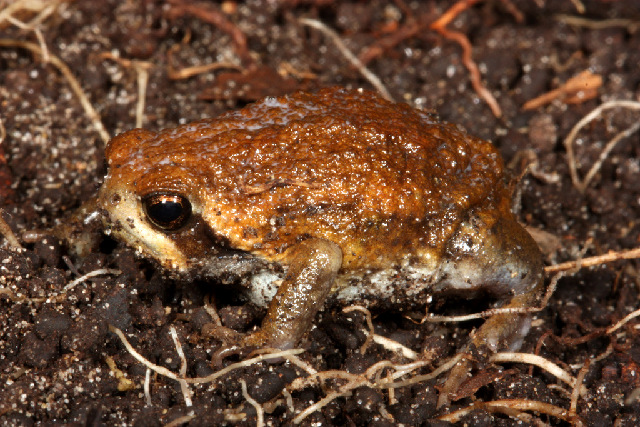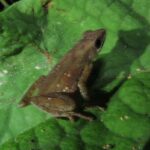- Breviceps bagginsi: Unveiling the Enchanting World of Africa’s Hobbit Frog
- Taxonomy and Classification: Understanding the Hobbit Frog’s Lineage
- Natural Habitat: A Hidden World Beneath the Misty Hills
- Physical Characteristics: Fascinating Form and Function
- Behavior and Life Cycle: A Subterranean Symphony of Survival
- Ecological Role: Guardians of Soil Health and Prey-Predator Dynamics
- Threats and Conservation Status: Protecting Our Hobbit Frogs
- Cultural and Scientific Significance: Bridging Fantasy and Nature
- Conclusion: Journey Onward Into the Hobbit Frog’s World
Breviceps bagginsi: Unveiling the Enchanting World of Africa’s Hobbit Frog#
Beneath the lush, grassy slopes of South Africa’s misty uplands, a curious sound rises softly from the earth itself—a gentle, rhythmic pulsing like distant drumming or subterranean whispers. To the intrigued ear, it evokes visions of mystic storybook creatures, and fittingly so—for the source of this murmuring melody is as enchanting as its call suggests. Meet the Breviceps bagginsi, affectionately known as the Hobbit Frog, one of nature’s captivating amphibian gems.
Named whimsically after J.R.R. Tolkien’s literary hero Bilbo Baggins, the newfound species has quickly captured the hearts of both scientists and amateur herpetologists alike. Although diminutive in stature, B. bagginsi is a charismatic ambassador for biodiversity, illuminating the ecological wonders of the region and inspiring enthusiastic conservation efforts. Embark upon a narrative journey into the captivating life of this remarkable amphibian—a creature that bridges fantasy and reality in the mist-shrouded hills of Africa.
Taxonomy and Classification: Understanding the Hobbit Frog’s Lineage#
Breviceps bagginsi belongs to the Microhylidae family, renowned for their small stature, rounded body shapes, and curious subterranean lifestyles. Within this family, the genus Breviceps encompasses small, plump-bodied frogs known commonly as rain frogs, characterized by their spherical form and burrowing behaviors.
Officially described in 2003 by Clarke and colleagues, B. bagginsi provoked immediate delight due to its unusual morphology and charming behavior, prompting its imaginative naming after a beloved literary character. The unique epithet “bagginsi” serves as a gentle nod to Bilbo Baggins, referencing the frog’s small size, round shape, distinctive facial expression, and preference for an underground lifestyle—traits humorously reminiscent of Tolkien’s hobbits.
Closely related species, such as Breviceps mossambicus and Breviceps fuscus, share habitats overlapping or adjacent to B. bagginsi, though differentiation remains clear through unique call patterns and distinct morphological details.
Natural Habitat: A Hidden World Beneath the Misty Hills#
Endemic to South Africa, the habitat of B. bagginsi encompasses primarily the cool montane grasslands of the southern Drakensberg region. Here, sweeping grass-covered hills undulate in an endless sea of emerald hues, occasionally punctuated by rocky outcroppings and secluded valleys cloaked in mist.
This amphibian’s preference rests firmly in habitats of cooler moisture-rich climates, preferably between elevations of 1,500 and 2,000 meters. Beneath the rolling turf lies an extensive subterranean labyrinth, composed of loose, moist, and richly organic soils—perfect quarters for this elusive burrower. The region’s persistent mist and regular rainfall create perpetually damp conditions, nurturing vegetation and the tiny invertebrates upon which the Hobbit Frog depends.
The quiet, cryptic existence of B. bagginsi has allowed it to thrive in relatively undisturbed corners, cleverly avoiding human notice. However, as potential threats loom with changing climate and land-management practices, understanding and protecting this habitat has come into sharp scientific and conservation focus.
Physical Characteristics: Fascinating Form and Function#
At first glance, Breviceps bagginsi is irresistibly endearing: a tiny amphibian seldom exceeding 25 millimeters in length. Its round and stout body is crowned by a head bearing a face marked by disproportionately large, expressive eyes that accentuate a charming resemblance to its fictional hobbit namesake.
The coloration of B. bagginsi is subtle yet ingenious, featuring hues ranging from deep browns to olive greens. Its intricately mottled pattern and muted palette provide camouflage akin to damp soil and moss-covered stones, rendering it virtually invisible against its natural surroundings.
Notably, this diminutive frog exhibits legs short and robust, optimized for burrowing rather than jumping—an adaptation specifically suited to a life spent predominantly underground. The skin of B. bagginsi is smooth yet somewhat granular, a texture perfect for retaining vital moisture in its subterranean habitat. This remarkable physical form facilitates minimal energy expenditure and effective concealment beneath the grassy hills, enhancing survival amidst unpredictable environmental conditions.
Behavior and Life Cycle: A Subterranean Symphony of Survival#
The Hobbit Frog’s secretive lifestyle plays out within underground chambers, constructed laboriously in the soft soils below damp grass tufts. Often solitary, these frogs rarely emerge onto the surface except after rainfall or for the purpose of mating. Unlike other amphibian species, rain frogs do not leap but use short, shuffling motions, appearing almost endearingly awkward when occasionally glimpsed above ground.
Feeding Habits and Diet#
Beneath its grassy haven, B. bagginsi adeptly locates its prey—primarily consisting of ants, termites, and other small soil-dwelling invertebrates. Quietly waiting or slowly exploring its subterranean domain, this gentle predator relies on stealth more than agility, capturing its nourishment efficiently yet casually.
Reproduction and Parental Care#
Breeding primarily occurs during the regional rainy season, coincident with increased surface moisture, allowing temporary emergence from the subterranean world. Males vocalize from concealed positions in soil cavities, releasing a unique, pulsating call to attract females; these calls, though audible at close range, are surprisingly subtle—evocative of murmurs resonating gently from underground.
Unlike many other frog species, female Hobbit Frogs lay disproportionately large eggs in secluded subterranean chambers, and rather uniquely, they do not undergo an aquatic tadpole stage. Instead, embryos fully develop within the eggs, eventually hatching into miniature versions of the adults. This direct-developing strategy completely eliminates dependence on standing water bodies—a vital evolutionary adaptation in their upland habitat.
Ecological Role: Guardians of Soil Health and Prey-Predator Dynamics#
Although small and subterranean, the Hobbit Frog occupies an indispensable niche within its environment. As an efficient consumer of soil insects, it contributes significantly to controlling insect populations, indirectly affecting nutrient cycling and soil aeration. Additionally, B. bagginsi is itself food for predators such as birds, small mammals, and larger amphibians, playing a subtle yet pivotal link in local food webs.
Threats and Conservation Status: Protecting Our Hobbit Frogs#
Currently, B. bagginsi is listed by the International Union for Conservation of Nature (IUCN) as Near Threatened. Its restricted endemic range, specialized habitat, and reliance on climatic stability render it particularly vulnerable to external pressures. Habitat alteration through agriculture expansion, overgrazing, and climate change impacts—manifesting in altered rainfall patterns and prolonged drought—pose emerging threats.
Thankfully, ongoing conservation initiatives, including protected area designations in the Drakensberg region, ecological research, and local conservation advocacy in South Africa, greatly bolster hopes for this unusual and intriguing species’ continued survival.
Cultural and Scientific Significance: Bridging Fantasy and Nature#
Appropriately named after Tolkien’s beloved literary character, B. bagginsi has uniquely captured public curiosity and served as an adorable gateway species for broader amphibian conservation dialogues. Its discovery highlights the importance of studying and protecting even obscure, tiny creatures, emphasizing the vast unexplored biodiversity still concealed within our world’s underappreciated ecosystems. The Hobbit Frog’s narrative exemplifies how imaginative naming and public engagement can invite broader awareness and foster support for conservation.
Conclusion: Journey Onward Into the Hobbit Frog’s World#
In the quiet grassland foothills of South Africa, beneath dewy blades and through soil alive with unseen dramas, the Hobbit Frog continues to whisper its delicate songs. Through their quirky charm and ecological significance, the frogs remind us passionately to cherish this vibrant tapestry of life. Let their whispered melodious calls quicken our commitment—echoing in inspired actions that safeguard not only this diminutive species but myriad others sharing its magical domain.
In heeding their subtle songs, we honor the nuanced wonders of our wild planet—a poetic tale authored by nature itself, ever inviting conservation advocates, passionate wildlife enthusiasts, and curious wanderers alike, to cherish and defend.








